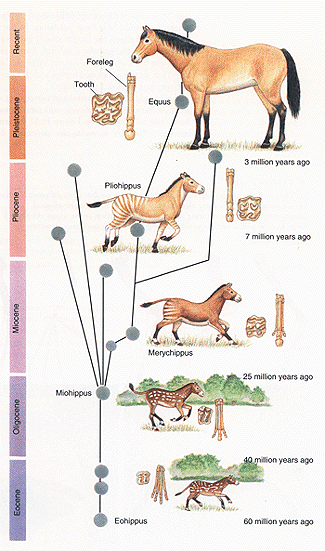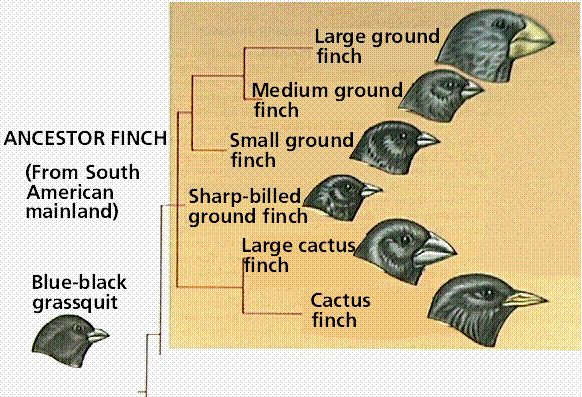
SC.912. L.15.1 Evidence for Evolution
C.912.L.15.1 Evolution Refer to EOC Coach Evidence for Evolution and Hominid Evolution Handouts and Textbook Chapter 17 and 18.3 and 18.4
-
You need to know how the theory of evolution is supported by evidence from:
1. The Fossil Record
2. Comparative anatomy
3. Comparative embryology
4. Biogeography
5. Molecular biology (DNA evidence)
6. Observed evolutionary change.
TUTORIALS
What is the Evidence for Evolution?
Evolution : Examining the Evidence
EOC Practice Questions
The scientific theory of evolution offers the strongest scientific explanation of how organisms have changed over very long periods of time
1. Fossil Record
The fossil record shows how the types and distribution of organisms on Earth have changed over time.Fossils can show patterns of change that happened over millions of years.
The horse slowly became larger and stronger
2. Comparative Anatomy
The similarities of structures in different vertebrates provide evidence that all vertebrates share a common ancestor
Homologous structures The limbs have similar structures, so the organisms may have a common ancestor
3. Comparative embryology
Shows similar embryonic stages in different organisms
All vertebrate embryos have similar genes and follow a similar developmental path.
It provides evidence that these animals came from a common ancestor and have inherited similar phases of development
4. Biogeography
Biogeography is the study of where organisms live now and where they and their ancestors lived in the past. There are two patterns important to biogeography.
Distantly Related but Similar (Convergent Evolution). Distantly related species can evolve similar adaptations if they live in similar environments.
The picture shows different species, Giant Armadillo, Giant Anteater, Giant Pangolin, and Spiny Anteater. Each has evolved powerful front claws, a long snout, and a tongue cover with sticky saliva which allows them to feed on ants and termites.
Closely Related but Different (Divergent evolution): Closely related species can evolve diverse adaptations in different environments. Organisms descended from a common ancestor (they are related) but evolved differently in response to their environment.
5. Molecular biology (DNA evidence)
Differences in amino acid sequences and DNA sequences are greater between species that are more distantly related than between species that are more closely related.
6. Observed evolutionary change.
Speciation is the evolution of a new species from an existing species. New species can arise when a population is separated into groups that cannot reach each other to interbreed. Bacteria have developed resistance to certain types of antibiotics.







This benchmark SC.912.L15.1 Evidence for Evolution will be assessed together with nature of science benchmarks. You will need to draw scientific conclusions based on the evidence or scenario given
Evolution:The process by which organisms change over time.
Speciation is the evolution of a new species from an existing species. New species can arise when a population is separated into groups that cannot reach each other to interbreed. Evolution is believed to occur in two ways Gradualism or Punctuated Equilibrium
Gradualism: Evolution occurs over a long period of time. Change is slow and constant, with small differences between generations. This how Charles Darwin believed that natural selection worked.
Punctuated Equilibrium: States that evolution occurs in spurts. Example Bacteria have developed resistance to certain types of antibiotics.
Gradualism Vs Punctuated equilibrium Tutorial
The island of Madagascar, off the Southeastern coast of Africa, has many endemic species of plants and animals Isolation from other landmasses caused unique evolutionary paths, resulting in a variety of unique species.

SC.912.L.15.10 You need to know trends in hominid evolution from early ancestors six million years ago to modern humans including brain size, jaw size, language and manufacture of tools.
Hominids are the family of organisms that include humans. As hominids have evolved, their appearance, anatomy, and behavior have changed.
1. Bipedalism, the ability to walk upright on two legs.
2. An increase in cranial capacity or brain size
3. Changes in skull shape, including a decrease in the size of the brow ridge (the thick section of bone above the eyes)
4. A decrease in in jaw size and the angle at which the jaw protrudes from the face
5. A decrease in the size of the teeth
6. Development of the ability to make and use tools
7. Development of the ability to communicate using language


SC.912.N.3.4 You need to know the differences between a theory and a law and know how a theory is developed over time.
Theories are well supported EXPLANATIONS
Laws are well supported DESCRIPTIONS
A theory is a well tested explanation that unifies a broad range of observations and hypotheses and that enables scientists to make accurate predictions about natural phenomena. If new information becomes available, the theory changes. Scientific theories explain how something might happen.
A theory NEVER becomes a Law
A law is a description of natural phenomena. A phenomenon of nature that has been proven to invariably occur whenever certain conditions exist or are met. Laws describe relationships.
A law NEVER becomes a theory
You need to know how specific scientists like Darwin, Lyell, Malthus, Mendel, Wallace contributed to the theory of evolution.
Darwin 1831-1859
Proposed that individuals that have physical or behavioral traits that better suit their environment are more likely to survive and will reproduce more successfully than those that do not have such traits, he called this Natural Selection.
He also suggested that organisms differ from place to place because their habitats present different challenges to, and opportunities for, survival and reproduction. An adaptation is an inherited trait that has become common in a population because the trait provides a selective advantage.

Ideas That Influence Darwin
Lyell 1830-1833
He concluded that Earth is extremely old and that the process that changed Earth in the past are the same processes that operate in the present.
Example: He recognized the connection between geological process and geological features like mountains, valleys and layers of rock that seemed to be folded. Some rocks form from molted magma, some form very slowly, as sediments build up and are squeezed together. He argued that laws of nature are constant over time this is known as uniformitarianism
Darwin wondered, if Earth's surface could change over time, could life also change over time?
Knowing that Earth could change over time helped Darwin realized that life might changed as well.

Malthus 1798
He reasoned that if the human population grew unchanged, there wouldn’t be enough living space and food for everyone.
Darwin realized that this was true for all organisms not just humans.

Crowded condition in London during Darwin's lifetime
Mendel
The first law, the Law of Segregation, (alleles separate) states that during fertilization each parent passes on one allele for each trait. Which allele the offspring would get from the parents is random.
The second law, the Law of Independent Assortment, states that transmission of one trait does not affect the transmission of other traits.
The third law, the The Law of Dominance, states that one type of allele (the dominant) could mask the other (the recessive)
Darwin realized that natural variations provide the raw material for evolution
Wallace 1855
He was a co-discoverer of the theory of evolution— though Darwin has gotten most of the credit. He wrote a letter to Darwin speculating on evolution by natural selection, based on his studies of the distribution of plants and animals during an eight-year expedition to what was then the Dutch East Indies — modern-day Indonesia